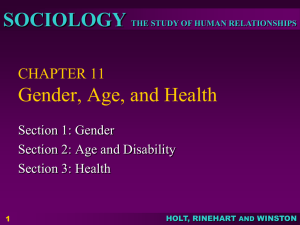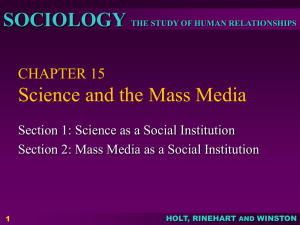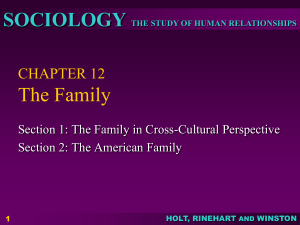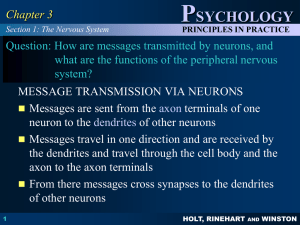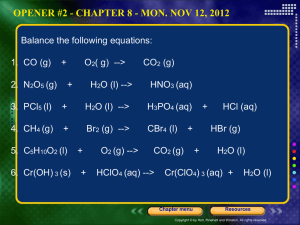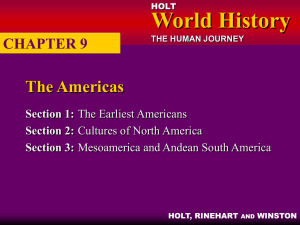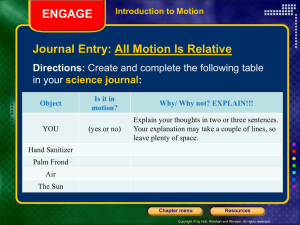CHAPTER 12 ADULTHOOD
advertisement
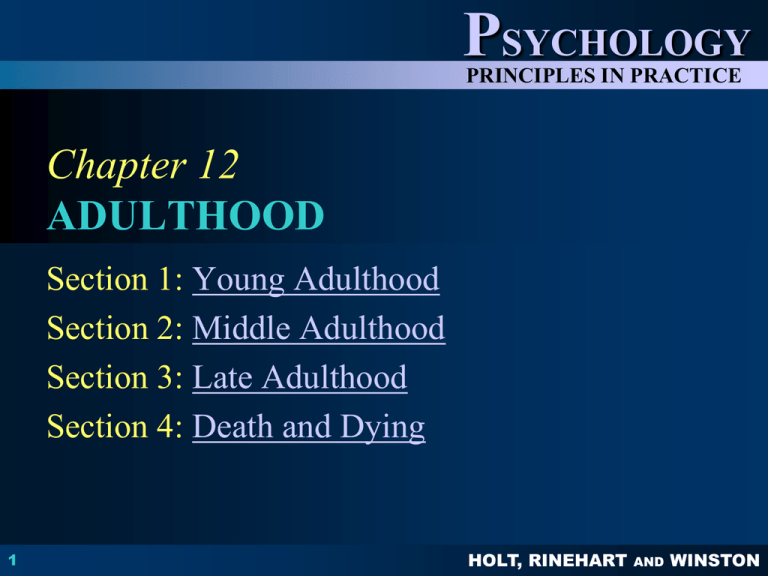
PSYCHOLOGY PRINCIPLES IN PRACTICE Chapter 12 ADULTHOOD Section 1: Young Adulthood Section 2: Middle Adulthood Section 3: Late Adulthood Section 4: Death and Dying 1 HOLT, RINEHART AND WINSTON Chapter 12 PSYCHOLOGY PRINCIPLES IN PRACTICE 2 HOLT, RINEHART AND WINSTON Chapter 12 PSYCHOLOGY PRINCIPLES IN PRACTICE Stages of Adulthood Young Adulthood (early adulthood)- 20-40 yrs old Middle Adulthood (40-65 yrs) Late Adulthood (65+) 3 HOLT, RINEHART AND WINSTON Chapter 12 PSYCHOLOGY PRINCIPLES IN PRACTICE Young Adulthood- Physical People reach physical peak in their 20s. Faster, stronger, better coordinated At height of cognitive powers Health habits are important during this time. Time to try new ways of doing things and relationship with parents start changing. 4 HOLT, RINEHART AND WINSTON Chapter 12 PSYCHOLOGY PRINCIPLES IN PRACTICE Young Adulthood goals in males and females Becoming independent and individuals (separate from parents and peers) was said to be a goal for young adult men (1994) Women were less concerned with seeing themselves as separate, independent individuals. More interested in creating relationships. (Gilligan 1990-1991) Generalization of women, remember some not all and this is changing as society changes. 5 HOLT, RINEHART AND WINSTON Chapter 12 Section 1: Young Adulthood PSYCHOLOGY PRINCIPLES IN PRACTICE Question: What are the characteristics and issues of young adulthood? CHARACTERISTICS AND ISSUES OF YOUNG ADULTHOOD Reassessment of what course in life they have chosen Urge to settle down when in their thirties Formation of marriage and intimate relationships 6 HOLT, RINEHART AND WINSTON Chapter 12 PSYCHOLOGY PRINCIPLES IN PRACTICE Levinson’s stages of Adulthood Levinson’s stages of Adulthood Early Adult Transition (age 17-22) Entering the Adult World (22-28) Age 30 Transition (28-33) Settling Down (33-40) Mid-Life Transition (40-45) Entering Middle Adulthood (45-50) Late Adulthood (60+). 7 HOLT, RINEHART AND WINSTON Chapter 12 PSYCHOLOGY PRINCIPLES IN PRACTICE Levinson’s stages http://education- portal.com/academy/lesson/levinsons-stagesof-adult-development-theory.html#lesson 8 HOLT, RINEHART AND WINSTON Chapter 12 PSYCHOLOGY PRINCIPLES IN PRACTICE Reassessment: In 20’s, Choosing course in life that is exactly right 9 for them, often reevaluate the decision in early 30’s. Is this really what they want? In 30’s may start new careers. Women might think about their biological clock ticking Women might feel overwhelmed with work and home responsibilities Can women have it all? HOLT, RINEHART AND WINSTON Chapter 12 PSYCHOLOGY PRINCIPLES IN PRACTICE Settling Down Mid to late 30’s– settling down or “planting 10 roots” Increase the financial and emotional investments they make in their live Promotions and pay raises if employed long enough Focused on advancing careers and gaining stability in personal lives HOLT, RINEHART WINSTON AND Chapter 12 PSYCHOLOGY PRINCIPLES IN PRACTICE Developmental Tasks of Young Adulthood Exploring adult role Becoming independent Developing intimate relationships Adjusting to living with another person Starting a family and becoming a parent Assuming the responsibilities of managing a home Beginning a career or job Assuming some responsibilities in the larger community Creating a social network of friends a coworkers 11 HOLT, RINEHART AND WINSTON Chapter 12 PSYCHOLOGY PRINCIPLES IN PRACTICE Marriage and Intimate relationships Important part of adolescence and young adulthood is 12 Identity Who you are and what you stand for (values) Identity brings personal stability Erik Erikson’s key task for young adulthood is forming of relationships (intimacy v isolation) Relationships can be difficult to sustain when one or both of the people involved lack personal stability. HOLT, RINEHART AND WINSTON Chapter 12 PSYCHOLOGY PRINCIPLES IN PRACTICE Marriage and Intimate relationships Intimate relationship- not necessarily a physical relationship, but a trusting, close friendship with another person in which one can be honest without fear or rejection. 13 HOLT, RINEHART AND WINSTON Chapter 12 PSYCHOLOGY PRINCIPLES IN PRACTICE Marriage Census 14 HOLT, RINEHART AND WINSTON Chapter 12 PSYCHOLOGY PRINCIPLES IN PRACTICE History of Marriage Western cultures: Men played dominant role in marriage and in society Known as a Patriarchy system This has changed and spouses are now more likely to be considered equal partners in marriage 15 HOLT, RINEHART AND WINSTON Chapter 12 PSYCHOLOGY PRINCIPLES IN PRACTICE History of marriage Marital roles: still changing Traditional roles: husband is the breadwinner and wife is the homemaker Now some couples share the roles or even reverse them. Reasons to marry: Love did not become widespread until the 1800s. 1600s and 1700s—arranged marriages by parents, and would usually benefit both families. Orderly transition of wealth from one family to another and from one generation to the next Today central goals in most marriages are companionship and intimacy. Feeling of security and opportunities to share experiences and ideas with someone special. Most young adults strongly believe marriage should be a lifetime commitment. 16 HOLT, RINEHART AND WINSTON Chapter 12 PSYCHOLOGY PRINCIPLES IN PRACTICE Choosing a spouse What are qualities/factors you think you would look for in a spouse? 17 HOLT, RINEHART AND WINSTON Chapter 12 PSYCHOLOGY PRINCIPLES IN PRACTICE Choosing Spouses Ethnicity/Race Level of education Social class Religion 18 HOLT, RINEHART AND WINSTON Chapter 12 PSYCHOLOGY PRINCIPLES IN PRACTICE Choosing a spouse In the US people tend to be like their mates in race and religion A study finds that 8.4 percent of all current U.S. marriages are interracial, up from 3.2 percent in 1980. Majority of marriages between people of the same religion Marital partners also tend to be similar in physical attractiveness, attitudes, personality traits, and intelligence 19 HOLT, RINEHART AND WINSTON Chapter 12 PSYCHOLOGY PRINCIPLES IN PRACTICE Choosing a Spouse Tend to choose partners who are near their own age Meet in school, marry each other tend to be similar 20 ages. Most men are 2-5 years older than women they marry. Being similar to your spouse does not necessarily mean your marriage will be more successful, than if you were opposites. HOLT, RINEHART AND WINSTON Chapter 12 PSYCHOLOGY PRINCIPLES IN PRACTICE Reading Read and answer the questions from the reading “Making Relationships Work” 21 HOLT, RINEHART AND WINSTON Chapter 12 PSYCHOLOGY PRINCIPLES IN PRACTICE Divorce When Marriage doesn’t work… Many marriages end in divorce 22 HOLT, RINEHART AND WINSTON Chapter 12 PSYCHOLOGY PRINCIPLES IN PRACTICE Divorce Variety of factors caused the divorce rate to rise from 1970- 1990. Obtaining a divorce easier now Financial independence of women Thought that marriage is easy and constantly gratifying. Divorce has many financial and emotional costs for people involved Property and income usually divided Women usually granted custody of children Fathers mostly pay for child support and alimony Can be hard for people going through divorce, but can also be a time of growth and renewal. 23 HOLT, RINEHART AND WINSTON Chapter 12 PSYCHOLOGY PRINCIPLES IN PRACTICE Children of Divorce Divorce can be difficult for children of all ages When both parents share an interest in their children, children tend to fair better Children may develop low self esteem, anger, they may blame themselves for the divorce May have trouble trusting the commitment of relationships as adults Troubles may not stem from just the divorce but the changes that follow: moving, step-families, etc. 24 HOLT, RINEHART AND WINSTON Chapter 12 Section 2: Middle Adulthood PSYCHOLOGY PRINCIPLES IN PRACTICE Question: What are the changes that occur and the issues that are faced in middle adulthood? CHARACTERISTICS AND ISSUES FACED IN MIDDLE ADULTHOOD Generativity – the ability to create, originate, and produce Transition – a period when people’s perspectives change in a major way that usually occurs somewhere between the ages of 40–45 Empty-Nest Syndrome – the feelings of emptiness and loss mothers and fathers sometimes feel after their children have left home 25 HOLT, RINEHART AND WINSTON Chapter 12 PSYCHOLOGY PRINCIPLES IN PRACTICE Middle Adulthood 40-65 Most people tend to lose the strength, coordination, and stamina that they once had in their 20’s. Gradual decline- not obvious People can work on their health and strength during this time 26 HOLT, RINEHART AND WINSTON Chapter 12 PSYCHOLOGY PRINCIPLES IN PRACTICE Developmental Tasks of Middle Adulthood 27 Helping one’s children make the transition from life to the outside world Strengthening one’s relationship with one’s spouse Helping make the world a better place by assuming leadership roles in social and civic activities. Achieving mastery in one’s career Adjusting to the physical changes that occur in middle age Making decisions about how to spend one’s “second adulthood” Pursuing one’s passions Coping with one’s ageing parents HOLT, RINEHART AND WINSTON Chapter 12 PSYCHOLOGY PRINCIPLES IN PRACTICE Generativity According to Erikson- Generativity is the greatest challenge for middle-aged adults Generativity– the ability to create, originate, and produce Adds meaning to life and helps maintain and enhance self-esteem 28 HOLT, RINEHART AND WINSTON Chapter 12 PSYCHOLOGY PRINCIPLES IN PRACTICE Mid-life Transition Midlife transition- 40-45 Lived about half their lives– years they have left Turning point Generational shift– losing a parent, now the head of the 29 family Women tend to go through mid-life transition around 35. Why? People may acknowledge dreams they had when they were younger might not come trueHOLT, RINEHART AND WINSTON Chapter 12 PSYCHOLOGY PRINCIPLES IN PRACTICE Midlife Crisis or Age of Mastery Midlife transition may trigger a second reassessment – Midlife Crisis Can be a positive thing– new career, new hobbies, creativeness, new interests. Middlescience: A period of searching that in some ways resembles adolescence Search for a new identity or a Second adulthood 30 HOLT, RINEHART AND WINSTON Chapter 12 PSYCHOLOGY PRINCIPLES IN PRACTICE Empty Nest Syndrome Empty-nest syndrome- the feelings of emptiness and loss mother and sometimes fathers supposedly feel after the children have left home to establish their own lives. Contemporary research Marriages and other parts of parents lives may 31 become happier Increased freedom and new opportunities HOLT, RINEHART AND WINSTON Chapter 12 PSYCHOLOGY PRINCIPLES IN PRACTICE Menopause Menopause- end of menstruation usually occurs in a woman’s late 40’s or 32 early 50’s. Decrease in hormones- estrogen and progesterone Women no longer produce egg cells that can be fertilized Other body changes occur Hormonal changes may cause discomfort Hot flashes fatigue and mood swings Psychological changes are often more important than the physical changes May feel less attractive Less of a woman HOLT, RINEHART AND WINSTON Chapter 12 PSYCHOLOGY PRINCIPLES IN PRACTICE Menopause Men– decline in hormones around 40-50 years 33 old Gradual drop off Loss of strength, weight gain, reduced energy, and decreased fertility Could be from gradual loss of human growth hormone rather than a diminishing in testosterone. HOLT, RINEHART WINSTON AND Chapter 12 Section 3: Late Adulthood PSYCHOLOGY PRINCIPLES IN PRACTICE Question: How do people’s lives change in late adulthood? HOW LIVES CHANGE IN LATE ADULTHOOD Physical Changes – wrinkles, skin folds, decline in sense of smell, slower reflexes Cognitive Changes – memory ability declines Social Changes – new decisions such as retirement and where they should live 34 HOLT, RINEHART AND WINSTON Chapter 12 PSYCHOLOGY PRINCIPLES IN PRACTICE Late Adulthood 65+ Physical changes Wrinkles Decline of the senses Reflexes and reactions become slower Bone become more brittle (risk of falling) 35 HOLT, RINEHART AND WINSTON Chapter 12 PSYCHOLOGY PRINCIPLES IN PRACTICE Late Adulthood-why do people age? Why do some people seem to age slower than others? 2 theories Programmed theories maintain that aging is a result of genetics Cellular damage theories maintaining that aging occurs because the body’s cells become worn out and damaged 36 HOLT, RINEHART AND WINSTON Chapter 12 PSYCHOLOGY PRINCIPLES IN PRACTICE Cognitive changes The great majority of older people have no serious decline in intellectual skills Some memory loss happens, but most isn’t serious The more serious cognitive changes do occur dementia and Alzheimer’s disease 37 HOLT, RINEHART AND WINSTON Chapter 12 PSYCHOLOGY PRINCIPLES IN PRACTICE Cognitive Changes Dementia: serious loss of cognitive functioning Major losses in memory Speech problems Unable to perform simple tasks Dementia after 65 is Senile Dementia, most cases 38 occur in people over 80. Longer a person lives the more time dementia will show up. HOLT, RINEHART AND WINSTON Chapter 12 PSYCHOLOGY PRINCIPLES IN PRACTICE Cognitive Changes Alzheimer’s Disease: most common cause of dementia Effects 10% of people in the US over age of 65 Alzheimer’s disease like other kinds of dementia is connected with aging but it is not a normal part of the aging process 39 HOLT, RINEHART AND WINSTON Chapter 12 PSYCHOLOGY PRINCIPLES IN PRACTICE Alzheimer’s Disease 40 HOLT, RINEHART AND WINSTON Chapter 12 PSYCHOLOGY PRINCIPLES IN PRACTICE Cognitive changes Causes of Alzheimer’s is unknown Heredity Viral infections Aluminum poisoning 41 HOLT, RINEHART AND WINSTON Chapter 12 PSYCHOLOGY PRINCIPLES IN PRACTICE Social Changes Retirement- about 65-70 yrs old Grandparenthood- different from parenthood Living arrangements 42 HOLT, RINEHART AND WINSTON Chapter 12 PSYCHOLOGY PRINCIPLES IN PRACTICE Successful aging Ego integrity– the belief that life is meaningful and worthwhile even when physical abilities are not what they used to be. Able to accept his or her approaching death as part of life. Positive outlook : blaming aches and pains on old age vs specific causes. A study of 1400 people aged 70+: Those who blamed the problems on aging were more likely to die sooner 43 HOLT, RINEHART AND WINSTON Chapter 12 PSYCHOLOGY PRINCIPLES IN PRACTICE Successful Aging Financial security Good health Supportive relationships All contribute to the likelihood of successful aging 44 HOLT, RINEHART AND WINSTON Chapter 12 PSYCHOLOGY PRINCIPLES IN PRACTICE Developmental Tasks of Late Adulthood Adjusting to physical changes and keeping or becoming 45 physically active Maintaining concern about other people so that one does not become preoccupied with one’s own physical changes Shifting interests from work to retirement or leisure activity Adjusting to changes in financial status Establishing fulfilling living arrangements Learning to live with one’s husband or wife in retirement Adjusting to the illness or the death of one’s spouse HOLT, RINEHART AND WINSTON Chapter 12 Section 4: Death and Dying PSYCHOLOGY PRINCIPLES IN PRACTICE Question: What are attitudes and issues related to death and dying? ATTITUDES AND ISSUES OF DEATH AND DYING Hospice alternative, euthanasia, living will The Funeral – usually reflects religious beliefs Bereavement – the mourning process 46 HOLT, RINEHART AND WINSTON Chapter 12 PSYCHOLOGY PRINCIPLES IN PRACTICE In your composition book… What is death? What is your greatest fear about dying? How would you want others to describe you after your death? 47 HOLT, RINEHART AND WINSTON Chapter 12 PSYCHOLOGY PRINCIPLES IN PRACTICE Stages of Dying-Kubler-Ross Denial– ex: dying person might think, “it can’t be me. The drs. 48 Diagnosis must be wrong Anger– ex: People in this stage might think “it’s unfair. Why me?” Bargaining –Ex “I’ll be kinder if I can just live to see my grandson’s graduation” Depression – “the person may despair and wonder “What’s the use of living another day Acceptance – The person reasons, “I’ve had a good life. I’m ready to die” HOLT, RINEHART AND WINSTON Chapter 12 PSYCHOLOGY PRINCIPLES IN PRACTICE Euthanasia- greek “Good Death” Controversial Living Will- legal document Hosptial vs Hospice Bereaved- mourning 49 HOLT, RINEHART AND WINSTON Chapter 12 PSYCHOLOGY PRINCIPLES IN PRACTICE 50 HOLT, RINEHART AND WINSTON PSYCHOLOGY Chapter 12 PRINCIPLES IN PRACTICE Question: What stages are characteristic of young adulthood? Young Adulthood Reassessment 51 Settling Down Marriage and Intimate Relationships HOLT, RINEHART AND WINSTON
